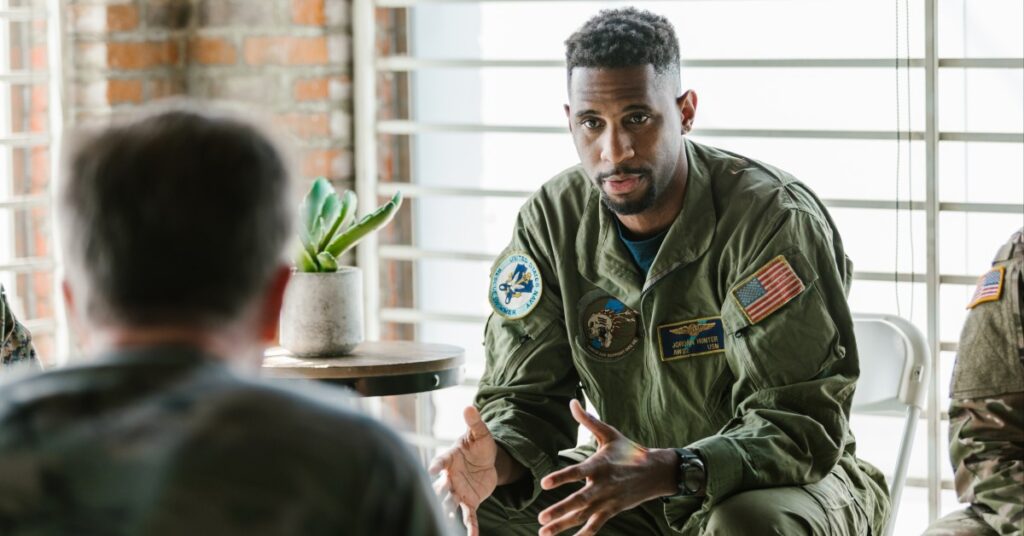
How to Choose an Online MBA
Online MBA programs make their degrees available to everyone everywhere, [...]

It feels like a cliché to say that veterans often face their toughest battles at home, but there’s a great deal of truth to this. It’s the reason that the US government created initiatives to facilitate servicepeoples’ entry to college or graduate school and prepare them for success in their post-military service careers. These education benefit programs include the GI Bill, the Post-9/11 GI Bill, the Veterans’ Educational Assistance Program (VEAP), and the Yellow Ribbon Program.
During the 2015-2016 academic year, there were 241,000 veterans in graduate school, comprising 6.7 percent of all graduate students nationwide—and 36 percent of all veteran graduate students received veteran’s education benefits from the federal government (some vets choose not to claim their educational benefits so that a dependent can use them later). However, without effective vet-specific school resources and peer support networks, some of these student veterans can struggle academically and socially during their course of study.
In a Military.com article titled “Veterans Returning to College Face Unique Challenges,” Tom Tarantino of the Iraq and Afghanistan Veterans of America, cautions: “If colleges are not prepared to help transition soldiers from combat, you do run the risk of losing an entire generation.” He added, “The GI Bill isn’t a thank you for your service. What it really is a readjustment benefit” so that servicepeople aren’t transitioning directly from the battlefield and back into civilian life.
Veterans interviewed for this article described how alienated they felt, especially when trying to relate to other students whose experiences were so different from their own. The schools’ bureaucratic systems also sometimes presented challenges for vets. Financial aid officers and counselors aren’t always adequately trained to handle the needs of veterans who can present unique financial situations and mental health challenges.
In some instances, federal tuition payment or reimbursement schedules don’t align with program calendars, forcing veteran students to contend with the stress late tuition payments at the bursar’s office or being short of funds in their personal or household budget while they wait for the government checks to show up. Additionally, during the 2015-2016 academic year 17.1 percent of veteran graduate students reported a disability (which can include blindness or visual impairment; hearing impairment; orthopedic or mobility impairment; speech or language impairment; learning, mental, emotional, or psychiatric condition, such as post-traumatic stress disorder (PTSD) or other health impairment or problem) that required some sort of accommodation or support.
Veterans face other unique challenges. They are used to functioning within a highly regimented environment and are not accustomed to advocating for themselves in less structured situations. They are uncomfortable with questioning authority (it’s discouraged in the military but welcome in academia). And since only about 7 percent of the US population are veterans of the armed forces, the majority of student veterans’ civilian peers lack knowledge or experience with the military. This unfamiliarity sometimes makes developing rapport with the student veterans a challenge.
Even so, student veterans offer considerable strengths—due to their military training and experience—that many traditional (civilian) students have not yet developed. These include having a broad worldview and an ability to communicate and relate with people from diverse backgrounds; possessing effective, real-world leadership skills; and being highly disciplined with a strong work ethic.
Schools can help meet these challenges and foster student veterans’ success by creating and maintaining support systems specifically designed for their demographic. This piece on veterans in graduate school: 8 keys to success explains what they are and how they help student veterans. This article also covers the following:
The 8 Keys to Veterans’ Success program is a combined effort of the US Department of Education (DOE), US Department of Veterans Affairs (VA), and US Department of Defense. It is designed to help veterans transition from military service to civilian life through degree completion and job search. (The 8 Keys to Veterans’ Success should not be confused with the Eight Keys of Excellence, which is a character education program for young people in elementary school, middle school, and high school.)
The 8 Keys were created under President Barack Obama’s administration and launched with pledges of support from 250 colleges and universities. In the ensuing years, the number of institutions committed to the 8 Keys has ballooned to more than 2,000. Though many schools recognize the initiative, it’s voluntary—each institution implements the keys without government oversight. (As a result, the DOE recommends veterans independently verify a school’s track record of supporting the 8 Keys before applying.)
According to the study “Best practices in serving college student veterans:
A scoping review” published in the Journal of Military, Veteran and Family Health, schools can meet this goal by setting up veteran-specific programs. By 2012, nearly 80 percent of schools had (or were planning to start) veteran programs. One common strategy is to provide a separate orientation specifically tailored for student veterans at which they can network and learn about student vet-specific programs, initiatives, and support groups.
Nationwide clubs like the Student Veteran Association (SVA) also serve this purpose. And schools like University of California – Santa Cruz and San Jose State University use peer mentors to help ease the transition for student veterans and they also serve as liaisons with faculty. UC Santa Cruz offers its program Veterans Education Team Support (VETS) through the Services for Transfer and Re-Entry Students Office. San Jose State offers a similar initiative called the Veterans Embracing Transition (VET) Connect program.
The “Veterans Toolkit” issued by the American Council on Education (ACE) asserts that schools must demonstrate top-down support to ensure that all student-veteran programs and initiatives are comprehensive, effective, and a priority for the institution. For instance, at Appalachian State University, school leadership implemented specific financial aid, grading, and registration policies for students called up for deployment—and, while they were gone, provided information regarding early enrollment, financial aid, and housing, as well as campus newspapers and support to their family members at home.
Schools must have systems in place to assist student veterans struggling with financial, academic, and employment issues. They cannot leave matters to individual professors and administrators to solve on their own.
To ensure their academic success, schools like Appalachian State University and West Kentucky University track student veterans’ progress across departments and offices to identify instances where they may need help—and to encourage them to seek out assistance to resolve the matter. Student veterans organizations also help connect vets with financial, academic, and job support. Boots to Suits at the University of Colorado Denver offers peer career mentoring, and the Peer Advisors for Veteran Education at the University of Michigan connects new student veterans with other vets to help them with navigating college life and accessing any resources they may need.
According to an ACE report, 71 percent of surveyed schools offer student veteran service offices, 68 percent offer student veteran clubs and organizations with dedicated student office spaces, and 47 percent offer student veteran-specific lounges. Studies show that schools with dedicated student veteran offices and spaces are more likely to offer specialized and regularly updated student veteran counseling and support groups as well as student vet-specific training to professors and administrative staff.
Schools adhering to the 8 Keys to Success goals have expanded the reach of their student veteran services beyond the institution. This means facilitating internship, mentoring, and job opportunities with local VAs, the SVA, and nonprofits like The Mission Continues. On the federal level, the VetSuccess on Campus initiative provides specialized vocational rehabilitation counselors and VA outreach coordinators that ensure the delivery of education benefits, academic and employment counseling, and referrals for VA health services.
Schools use data to track and improve their student veteran services, as well as the student veterans’ educational outcomes. However, there is no single database recording this data nationwide, so the Student Veterans of America commissioned and released a study in conjunction with the National Student Clearinghouse and the US Department of Veterans Affairs’ Veterans Benefits Administration titled the “National Veteran Education Success Tracker: A Report on the Academic Success of Student Veterans Using the Post-9/11 GI Bill.” This report answered questions like:
It’s impossible to provide appropriate educational services to student veterans without a well-trained faculty and administrative staff, particularly since the vast majority of them have little or no experience with the military. They must be informed about common veteran issues and how they can affect student veterans’ functioning and performance. According to the ACE study, 45 percent of schools offered faculty development and 60 percent provided staff development programs, like the University of Colorado at Colorado Springs’ training programs that address both traumatic brain injury (TBI) and PTSD.
None of the keys work without a commitment to the future. Schools must guide veterans through their programs and help them find jobs to launch their post-service careers. The Department of Education offers grants through programs like the Centers of Excellence for Veteran Student Success (CEVSS), Veterans Upward Bound, and Educational Opportunity Centers to help institutions meet this goal. College and university stakeholders must continually strive to improve how they accommodate veterans in the classroom and ease their transition back into civilian life.
Florida State University works closely with the SVA and retains about 88 percent of veteran students. San Jose State incorporates a Universal Design to help student veterans with different physical and psychological needs succeed in the classroom, according to the Journal of Military, Veteran and Family Health.
Of course, veterans can pursue any graduate degree they choose, but several dovetail well with military skillsets. Industries that are seeking driven professionals who can lead calmly under pressure and are problem-solvers, include healthcare (particularly nurses and EMTs), criminal justice, construction engineering, teaching, and information technology (IT), network administration, and cyber security.
According to JP Morgan Chase, veterans make excellent entrepreneurs for the same reasons as above— and veteran-owned businesses employ over four million people (and generate over $963.4 billion in receipts each year and have about $191.6 billion in annual payroll).
Earning a Master of Business Administration (MBA) can improve veterans’ business prospects. Like many graduate programs, students can complete MBAs full or part-time, in-person or online.
Using GI Bill education benefits to pay for an MBA can be a good choice for several reasons. Foremost among them, many MBA programs are expensive, so you can earn this valuable degree at little or no cost. As well, many top schools tailor their MBA program for veterans, helping them to successfully transition to business careers.
One MBA specialty that may appeal to veterans is aerospace and defense. Though not the most popular specialization, talented leaders in this area can be hard to come by. People with both a military and business background often excel in this realm.
In 2021, the US defense industry employed over 2 million workers and generated $874 billion in profits. Attending an MBA program with a aerospace and defense specialization like the ones offered by The University of Tennessee – Knoxville and the University of Oklahoma can prepare vets to start or advance a career in this booming field.
Though both programs offer the same specialty, they differ in execution. The University of Oklahoma offers an executive MBA (EMBA), designed for applicants with at least five years of relevant work experience. While the program is not specific about work experience requirements, most EMBA programs want applicants to have management experience before applying. Reaching the equivalent of a middle management rank in your military career may be useful. The University of Tennessee – Knoxville seeks applicants with defense experience and offers services geared specifically to military members.
Two of the best veteran education benefits that can cover graduate school tuition are the Post-9/11 GI Bill (an expansion of the original GI Bill) and the Yellow Ribbon Program The main difference between these programs is the Post-9/11 GI Bill applies covers in-state tuition at public institutions (and caps fees for out-of-state, private, and graduate schools), while the Yellow Ribbon program helps recipients pay for an education at a public university at the non-resident rate, a private institution, and graduate school tuition and fees that the Post-9/11 GI Bill doesn’t cover.
Both programs can fund up to 100 percent of a veteran’s education, depending on their service record—be sure to read their eligibility requirements closely.
(Last Updated on February 26, 2024)
Questions or feedback? Email editor@noodle.com

Online MBA programs make their degrees available to everyone everywhere, [...]

In 2004, Burton D. Morgan Foundation and other Cleveland organizations [...]

International marketers have to consider local language(s), local norms and [...]

Organizations must design facility layouts and workstations in a way [...]

Many aspiring entrepreneurs understand the basic idea that the firm [...]
Categorized as: Aerospace, Business & Management